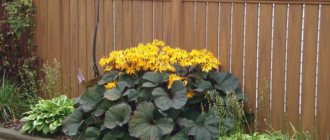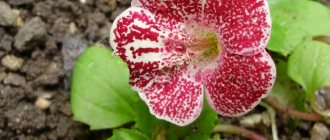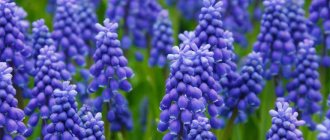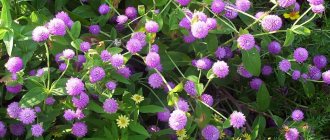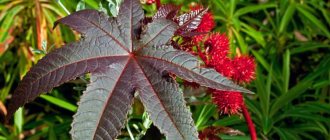Tenacious (Ajuga) are annual and perennial herbaceous plants from the Lamiaceae family. People call it ayuga, gourd, dubrovka, heart grass, dubrovnitsa and bitterweed; it blooms in May, as soon as the snow melts. It grows throughout the entire territory, except the Arctic Circle, preferring moist, shaded forests and rocky soils exposed to the sun. It spreads quickly throughout the territory due to its superficial rhizome.
In Russia, the most common species is the creeping tenacious (Ajuga reptans).
Description of the survivor
Herbaceous plant with two lips, 8 pcs. flowers from blue to white, collected in small inflorescences (spikelets). The corolla has an upper bilobed and a lower three-lobed lip.
The seeds ripen by the end of summer - the third ten days of July. In early August they appear as four bright brown fuzzy nuts. Under unfavorable weather conditions, the tenacious plant becomes a self-pollinating plant, and under favorable weather conditions, it is pollinated by bees.
The stem of this plant is erect, up to 0.5 m in height, has four sides, and can descend. At the bottom there are long oblong leaves, closer to the top they are short, jagged along the edges. The creeping tenacious has creeping shoots characteristic of this species. Over all this time, about 45 varieties of creeping ajuga have been bred (differing from each other in shade, both foliage and flowers).
Gardeners love it very much for its unpretentiousness, preferring to plant it along the fence and in the shade around trees and shrubs, on alpine hills, and also to create a creeping carpet.
The highlight of landscape design
Experienced gardeners use tenacity to create various compositions. It decorates shaded areas, turning them into a haven for relaxation. Against the background of tall trees and spreading bushes, the survivor looks like a soft carpet that attracts the eye. And in harmony with other garden flowers, masters create magnificent compositions. In the photo of the creeping tenacious plant in landscape design, all its charms are clearly visible.
It is an excellent addition to areas where lawn grass does not grow or dries out. An original base for an alpine slide and a highlight for the trunks of majestic trees. Those who have at least once been in a garden decorated with creeping tenacious will want to return there again.
Creeping tenacious, Geneva, pyramidal and Chios: photo and description
The most popular types of survivors are:
| Type and its characteristics | Varieties and their descriptions | Leaves | Inflorescences |
| Creeping. A ground cover flowering plant. | Metallica Crispa. Shoots crawl along the ground. | Dark brown with a metallic sheen. | Bright blue, terry. |
| Atropurpurea. Loves the sun. Up to 20 cm in height, creeping. It grows on its own and does not require close care. | Dense brick color with a bronze sheen. | Dark blue, growing crowded on the stem. | |
| Burgundy Glow. | Light green, blue, reddish, with pink spots and thin veins. Color depends on soil, feeding and light. The more light, the brighter and redder it is. A lack of microelements will give the effect of pallor. | Burgundy, blue-bluish. | |
| Multicolor. | The color changes depending on the lighting - in the sun it becomes bright purple with thin red or orange stripes, in the shade it becomes a thick green color with pink or yellow streaks. | Blue. | |
| Chocolate chips. It spreads quickly over loamy soils in partial shade and sun, forming a carpet 5 cm high. | Oval, green, small, can be purple (5-6 cm). | Cobalt shade. | |
| Pink elf. Small bush. Blooms for a long time. | Very small. | Pink. | |
| Rainbow. Creeping, very dense appearance without dips. | Spotted yellow to white on a dark green background. Similar to the Multicolor variety, but more saturated. | Lilac. | |
| Arctic fox. Loves sunny places and water. | Ordinary green ones, covered with white streaks (multi-colored lines), under which the color of the leaf itself is not even visible. | Pale blue. | |
| Polar snow (Arcticsnow). | Green corrugated with a large milky spot and whitish edges. (8-10 cm) | White. | |
| Chios. Low-growing up to 20 cm, at the base the stem branches into three, creating creeping shoots. It gets along well on rocky soils, fenced spaces and alpine hills. | No varieties. | Thin green, dark shade with fluff. | Small, yellow with scarlet specks. |
| Geneva or shaggy. Dark green shaggy stem, grows up to 50 cm. There are no creeping shoots. It is successfully used by traditional healers. | Helena. | Narrow, elongated oval. | Lilac. |
| Blue ocean. | Up to 20 cm, thick green, elongated, drooping. | Light blue, with clearly visible adjacent leaves. | |
| Pyramidal. It does not have creeping roots along the ground, is resistant to drought, grows slowly, resembles a pyramid. The stems are fleshy but fragile. Listed in the Red Book. | Metallica Crispa. | Deep dark green in color, oval, jagged along the edges, with white thin lines. | Dense purple color, can be white and pink. |
Planting by seeds
It is better to purchase seeds for planting at a garden store. Their germination rate is high. Seeds are sown in open ground in the spring. The soil must be well warmed up. Planting in autumn is also possible.
The plant will develop better in a shaded place. However, it will also grow well in a sunny area. Most often it is planted under a tree, since the ajuga will not take up many nutrients.
The most suitable for this flower are fertile loams and garden soils. Before sowing seeds into the soil, fertilize them with organic matter, superphosphate or complex mineral fertilizer.
Note! Transplantation is carried out in spring or autumn. The plant is dug up and planted in a new, previously prepared place.
Caring for ayuga in the garden
Until new leaves appear, the plant needs to be watered, the soil should be moist, it is better to shade the sprouts so that they are not in direct sunlight. As soon as the plant has taken root and started to grow, water moderately, only when the soil is completely dry.
Due to the superficial creeping roots, the tenacious plant very quickly fills the area. To avoid this, you need to press the plant a little into the ground, you can also fence it off with stones or gravel.
Application in landscape design
Unfavorable soil conditions and the presence of a large number of stones in the ground are not a problem for the survivor. In landscape design, this adaptability can be effectively used. It is recommended to plant it along garden paths when the space is limited by borders.
On the cramped alpine hills, only the tenacious Chios one looks great. The remaining varieties are best placed in a spacious rock garden. Plant tasks in the landscape:
- add structure to the hilly terrain;
- hide an unaesthetic corner of the garden;
- mask an empty area of infertile soil;
- plant a garden gazebo in the form of a hanging crop;
- help a novice gardener begin landscaping his site.
Other methods of reproduction
It is recommended to grow ayuga from seeds only if it is first grown in a garden plot. The tenacious plant can reproduce by self-sowing, and the grown specimens differ from the mother plant in the color of leaves and flowers; this also applies to seeds planted by hand.
To prevent the appearance of “other” species of this plant, you should cut off the arrow of exclusively deciduous plants, a tenacious plant that delights with different shades of inflorescences when they fade.
If you want to get a completely identical plant, then at the end of May or before the 20th of September it must be propagated by rosettes (this term refers to low-growing plants whose leaves are crowded to the root), replanting them in a new place. As soon as the plant takes root and begins to grow, they stop watering it.
The tenacious plant does not like damp soil and adapts well to arid lands.
Growing conditions
The survivors prefer semi-shaded and fully shaded places. They can be planted in a sunny location, but they require more moisture in the substrate. It is an excellent ground cover for any soil type, although it grows best in fertile areas. If you decide to grow varieties with variegated leaves, you should provide them with adequate access to light, otherwise they will lose their intense, rich color.
Optimal soil for survival:
- loamy-sandy;
- fertile;
- humus;
- rich in minerals;
- neutral: pH 7.0;
- quite wet.
Tenacious creatures have a rather shallow root system; the roots draw water from the upper layers of the soil.
If the soil is poor and dry, the survivor may die.
After flowering
It is impractical to collect seeds; it is possible to prevent self-seeding, but it is troublesome; different plants (that do not correspond to the mother specimen) spread very quickly on the site. For the same reason, you should not collect seeds manually, which is why many gardeners propagate the tenacious plant with rosettes.
This plant can easily survive a snowy winter, but if there is not enough snow, it is better to cover it with spruce branches, peat, and dead wood. Young plants must be covered for at least the first year.
Growing and care
The tenacious ones are not only very interesting and attractive, but also easy to grow. The plant grows well in our climate in the wild, so it does not cause any special care problems. These are quite extensive perennials that can choke out other species in a short time. They spread very quickly thanks to rooting shoots.
To prevent overgrowth throughout your garden, regularly remove unwanted shoots and new established rosettes.
Watering and fertilizers
The tenacious plant does not tolerate drought well, so you should remember to water it regularly. In the shade, the soil can be a little drier, this will protect the plants from mold and fungal diseases.
Before planting, the soil should be enriched with well-rotted compost. These plants do not require intensive mineral nutrition; it is enough to feed the tenacious plant in the spring with a multi-component slow-acting fertilizer, which will stimulate the plant to bloom profusely.
Trimming
After flowering, the inflorescences need to be cut off so that the tenacious plant does not spread its seeds throughout the garden and grows only in a certain area.
After flowering, large areas overgrown with tenacious plants can be mowed with a mower with high-set blades.
Care in autumn, wintering
Tenacious plants are completely frost-resistant plants; they do not need to be covered for the winter. However, during very frosty, snowless winters, the leaves can freeze, so you can cover them with branches of coniferous plants. We remove frozen bushes in the spring, the plants will grow back during the next growing season.
Diseases, pests
The tenacious ones are quite resistant to diseases and pests. However, under the wrong growing conditions they can get sick. Plants grown in areas that are too dry may be attacked by aphids. A humid growing environment can promote the appearance of powdery mildew (a fungal disease), the symptoms of which appear as a grayish coating on the leaves. As soon as symptoms appear, a fungicide must be applied immediately, otherwise the disease may spread to other plants, ornamental and cultivated. For aphids, an appropriate insecticide must be used.
Diseases and pests
| Name | Signs | Elimination methods |
| Fungal rot | When there is excess water, the roots and stems are affected by gray rot. As a result, the tenacious plant stops growing, blooming and producing new rosettes. | Immediately remove the affected stems and leaves; treat the remaining ones with Rovral, Kuproskat, Fundazol, Copper sulfate or Bordeaux mixture. If the root is affected, remove it too and treat the remaining root with crushed activated carbon or ash. |
| Slugs and snails | They eat the stem and leaves. | If a large concentration of slugs is found on the ayuga, the first drugs that need to be used are Meta and Thunderstorm. In addition, you can sprinkle with homemade mustard solution (250 g of mustard per 10 liters of water) or crushed pepper. In the fight against slugs, there is another method - deepen plastic cups into the ground next to the plant, filling them a little with beer or milk; in the morning you can find a catch of slugs in these cups. |
Compatibility with other plants
Due to the unusual and non-uniform color of the leaves, it is better to plant the tenacious plant next to monochromatic plants. It should also be remembered that ayuga is classified as an aggressor plant (it easily conquers territory from small flowers), so it is better to choose plants that can “defend” their territory as neighbors. Tenacious goes well with the following plants:
- ferns;
- iris;
- rudbeckia;
- loosestrife;
- delphinium.
If you don't already have ajuga in your garden, correct this mistake immediately! As you can see, this plant brings only pleasure: with its beautiful appearance, ease of care and reproduction, and wide compatibility with other plants. By planting a tenacious plant, you will acquire the most unpretentious and one of the most beautiful inhabitants of your flower garden!
Medicinal properties of tenacious
The composition of the tenacious has been studied rather poorly; it is known that it contains tannins. A decoction of this plant, as well as juice, is widely used to treat:
- For gastrointestinal diseases (stomach ulcer and gastritis), crushed leaves are brewed with boiling water in a glass, left for 2 hours, poured into a thermos or wrapped in a warm scarf, then drunk warm, 1 tbsp. l. three times a day.
- Female organs and genitourinary system, as an analgesic and expectorant, also for malaria. Use the decoction given above, but take it 5 times a day, also drink warm.
- For colds, brew creeping tenacious, linden flowers, lemon balm and oregano, all in equal quantities. Drink warm several times a day, the mixture causes increased sweating, which removes harmful substances and reduces temperature.
- If your hair grows poorly, you should rinse it with ayuge decoction more often.
- Healing wounds or bites. Make a paste from a freshly picked leaf and apply it to the site of a bee or other insect bite, as well as to a non-healing wound.
- For anorexia (painful thinness), take a bath at night, adding herbal tincture to the water.
How to use tenacious grass
If you don’t use it in decoration as a basis, then it’s worth talking about the medicinal qualities of the plant:
- Creeping. Infusions and decoctions from it have diuretic, anti-inflammatory, pathogenic and astringent properties. This variety allows you to regulate metabolism when it fails. It is enough to dry the grass, 2 tsp. pour a glass of boiling water over the mixture and leave it for a couple of hours. It is recommended to drink the remedy three times a day for 1.5 weeks.
- Turkestan. Its aerial part is used in the manufacture of the drug Exumida. It is necessary to stimulate protein processes in the human body. It should not be confused with synthetic anabolic steroids. The plant is used not only in sports medicine, but also in cosmetology.
- Herringbone. Tenacious grass of this variety is rarely used. Its healing properties are limited to helping men with diseases of the genitourinary system. This natural component will help if you initially coordinate treatment with your doctor.
- Geneva. Its juice is used as a hemostatic agent in gynecology. It will also help with wounds and skin inflammations.
Laxman's tenacity is used in cooking. Salads from its above-ground part are popular among gourmets.
This plant is also useful as a remedy for baldness and weight loss. To do this, just take a bath, into which you should pour 2 liters of water with 5 tbsp steamed in it. l. dried grass.




